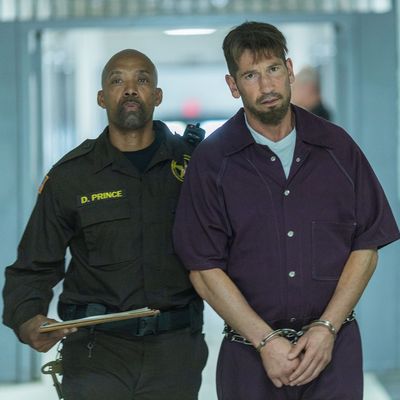
There’s a way to tell the story of Wayne Jenkins and the Gun Trace Task Force that frames them as a rogue unit, using its independence from the everyday rigors of the Baltimore Police Department to avoid accountability and steal money from citizens and from the government through an overtime scam. That’s not the story that We Own This City wants to tell because it would place the GTTF all too neatly in the “bad apple” file, with Jenkins as the ringleader of a unit full of egregiously corrupt or corruptible cops. By doing so, it would let the BPD itself completely off the hook.
The second hour of We Own This City makes it emphatically — sometimes too emphatically — clear that the GTTF is merely the by-product of an institution that incentivizes corruption and lawlessness within its own ranks. That’s why the structure of the show is so important: We have to learn about the crimes and the investigation, as well as the effort by the DOJ to report on root causes, but we also have to see Jenkins’s earliest days on the force and understand that perhaps there’s nothing particularly special about him at all. Bottom line: He represents the police. He’s not an anomaly.
“Part Two” hammers down on the aspect of city policing that’s purely a numbers game, which was also a major piece of The Wire, where dead bodies were handled like some terrible bureaucratic version of hot potato. For the beat cop, police work is not about arresting perpetrators of crimes who can then be duly processed by the court, it’s merely about clearing the corners of urban hot spots, like janitors for the rich and powerful. In order to keep the murder rate down — and thus to turn the city’s mayor into the future governor of Maryland — there have to be fewer people around to shoot or to get shot. Sometimes, it requires some creativity in terms of what the charges those under arrest actually face, and almost none of those charges will result in even a day’s worth of confinement, much less hearings and evidence and anything else associated with prosecution. It’s just the politics of public safety.
Jenkins learns it on day one of field training in August 2003. As command runs down the morning orders, Jenkins’s training officer says into his ear, “All that shit they told you in the academy about probable cause? Fuck that now. And what are they calling that … “cultural sensitivity training” they give you? Fuck that shit, too. This is Baltimore.” This moment comes back around a bit heavy-handedly two years later, when we see Jenkins, now coarsened by his own time on the beat, saying basically the same thing to a shiny-new cop fresh from the academy. There’s more to be revealed about the “This is Baltimore” part of the spiel — the arrogance and defiance of those words is not just about making a quote — but any idealism the young officer may have about public service is extinguished before he finishes his first cup of morning coffee.
What makes a David Simon and George Pelecanos show a David Simon and George Pelecanos show is that they back up their polemics with specifics. And so we get casually startling scenes like the one where Jenkins and his fellow blue bloods randomly throw three men against a wall, search their pockets, and charge them all with possession, even though weed is found on only one. And another where drugs discovered in a vacant lot are used for a similar purpose. And yet another, more surreal scene where a guy sitting on the corner stoop of his actual residence is told to go back inside or face arrest. The mass-processing of these absurd collars gets so absurd that an assistant state’s attorney is assigned to release people under the condition that they not sue the city for false arrest.
Nicole Steele’s monumental task for the civil-rights division of DOJ is to untangle such systemic wrongs, and we continue to follow her around in the part of the timeline that’s closest to the present day. Nicole’s focus remains on Daniel Hersl, who still seems to her like the biggest case study in racist and corrupt police practices. She speaks to a rapper named Young Moose, who referenced Hersl in one of his songs and talks to her about not only being harassed and charged by him but having Hersl steal money straight out of his pockets. She looks up another young Black man who earned a deep gash to the forehead for the crime of wearing a hoodie in a bad neighborhood. And, finally, she has her first sit-down with Hersl himself, who smugly accounts for his dozens of complaints by saying that cops who don’t get complaints don’t do any policing. Then he returns his beer and the bones of his chicken drumstick.
More thematic reinforcement comes in an FBI-interrogation scene of another one of Jenkins’s boys, Jamell, who addresses bigger robbery schemes than shaking down corner perps for loose change. Jamell recalls one big score in which he and another GTTF member pulled a man over and seized $11,000 in cash that the suspect claimed was the equity on a mortgage refinancing. They took the money with the proviso that he could get it back if he produced the bank receipts. More pertinent to the case, however, is Jamell’s breakdown of the robbery at Aaron Anderson’s place, which itself unlocks a long-standing relationship between Gondo, a GTTF colleague, and the drug kingpin Brill, who’s an old friend from the neighborhood.
The plot thickens. And most of the quality police work being done is scrutinizing the police.
Burners
• Jon Bernthal is just an electrifying actor, and his presence on a show this concerned with minutiae and process gives it a necessary dramatic pop. A simple scene of Jenkins waiting in the interrogation room bristles with energy because of Bernthal’s restlessness. Jenkins isn’t the type of guy who’s used to waiting on anything.
• You’d expect the police to close ranks around their leader in a situation like this, but what’s striking is that Jemell and the others can’t turn on Jenkins fast enough.
• Passing Suitor in a parking garage, Gondo can’t help but have a laugh at his expense: “You can’t even make any money working homicides.” Sucker.
• “Kid, there’s no dictatorship in America more solid than a beat cop on his post.”
• McDougall setting up a wire to track Brill’s phone calls is definitely an invitation for all of us to do the Leonardo DiCaprio’s pointing meme from Once Upon a Time … in Hollywood.
• “Hey, Tommy, how’s your wife and my kids doing?” Great closer to the episode. Leave ’em laughing.


